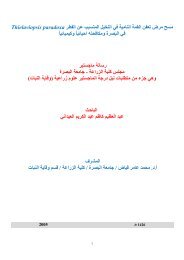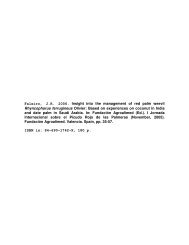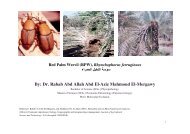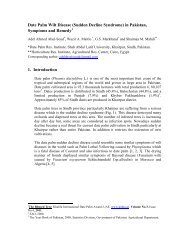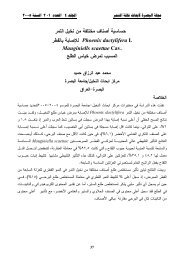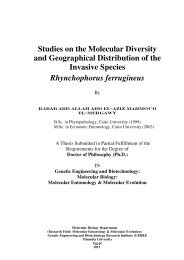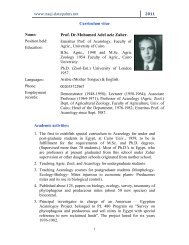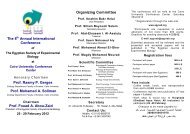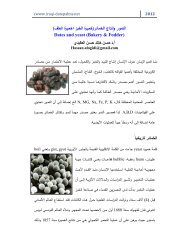The red palm weevil as an alien invasive: biology and the prospects ...
The red palm weevil as an alien invasive: biology and the prospects ...
The red palm weevil as an alien invasive: biology and the prospects ...
Create successful ePaper yourself
Turn your PDF publications into a flip-book with our unique Google optimized e-Paper software.
38N BiocontrolNews <strong>an</strong>d Information 1999 Vol. 20 No. 1<br />
<strong>The</strong> geographical distributions of <strong>the</strong>se five species are given in<br />
Table 1. Rhynchophorus ferrugineus is <strong>the</strong> most widely distributed<br />
species within tropical Asia <strong>an</strong>d its r<strong>an</strong>ge within this region extends<br />
from Pakist<strong>an</strong>, through Sou<strong>the</strong><strong>as</strong>t Asia to Mel<strong>an</strong>esia. <strong>The</strong> host<br />
pl<strong>an</strong>ts are listed in Table 2a. A wide r<strong>an</strong>ge of genera within <strong>the</strong><br />
Palmae is attacked although <strong>the</strong> literature records provide no<br />
evidence of <strong>an</strong>y preference by <strong>the</strong> <strong>weevil</strong> for <strong>palm</strong> species or genera<br />
for breeding purposes. <strong>The</strong>re are records of <strong>the</strong> <strong>weevil</strong> from <strong>palm</strong><br />
genera native to all are<strong>as</strong> apart from Pakist<strong>an</strong> <strong>an</strong>d Mel<strong>an</strong>esia, which<br />
suggests that all or part of <strong>the</strong> region extending from India through<br />
to Sou<strong>the</strong><strong>as</strong>t Asia could be <strong>an</strong> area of endemic focus. Nirula (1956)<br />
observes that in natural <strong>an</strong>d uncultivated are<strong>as</strong> within sou<strong>the</strong>rn<br />
India, R. ferrugineus is normally a rare <strong>an</strong>d local insect. However,<br />
<strong>the</strong> commercialization of coconut <strong>an</strong>d oil <strong>palm</strong> growing within<br />
tropical Asia, particularly <strong>the</strong> development of pl<strong>an</strong>tation<br />
monocultures, h<strong>as</strong> facilitated <strong>the</strong> r<strong>an</strong>ge exp<strong>an</strong>sion of this insect.<br />
Equally <strong>the</strong> commercialization of date <strong>palm</strong> growing in <strong>the</strong> Middle<br />
E<strong>as</strong>t h<strong>as</strong> created ideal conditions for <strong>the</strong> rapid spread of <strong>the</strong> <strong>red</strong> <strong>palm</strong><br />
<strong>weevil</strong> between countries in that region.<br />
<strong>The</strong> remaining four species of Rhynchophorus have more restricted<br />
r<strong>an</strong>ges, all of which are sympatric with R. ferrugineus.<br />
Rhynchophorus vulneratus (called <strong>the</strong> <strong>red</strong> stripe <strong>weevil</strong> in <strong>the</strong><br />
Oriental Region) is distributed from Sou<strong>the</strong><strong>as</strong>t Asia through to<br />
Mel<strong>an</strong>esia (Table 1) <strong>an</strong>d is found from a wide r<strong>an</strong>ge of <strong>palm</strong> species<br />
native <strong>an</strong>d exotic to <strong>the</strong> region (Table 2b). This <strong>weevil</strong> h<strong>as</strong> been<br />
recorded <strong>as</strong> a pest of coconut in Malaysia <strong>an</strong>d Thail<strong>an</strong>d.<br />
Considering only those <strong>palm</strong>s that are in its native r<strong>an</strong>ge, R.<br />
vulneratus h<strong>as</strong> been recorded from some species/genera common to<br />
R.. ferrugineus, e.g.Arenga, Corypha <strong>an</strong>d Areca. Interestingly,<br />
<strong>the</strong>re are no records from Caryota, which is a common host for <strong>the</strong><br />
<strong>red</strong> <strong>palm</strong> <strong>weevil</strong>. Palm genera attacked by R. vulneratus from which<br />
<strong>the</strong> <strong>red</strong> <strong>palm</strong> <strong>weevil</strong> h<strong>as</strong> not been recorded include Livistona <strong>an</strong>d<br />
Oncosperma; Watt<strong>an</strong>apongsiri (1966) reports that <strong>the</strong> Sou<strong>the</strong><strong>as</strong>t<br />
Asi<strong>an</strong> Oncosperma tigillaria is a prefer<strong>red</strong> host for breeding.<br />
Rhynchophorus vulneratus h<strong>as</strong> been synonymized with R.<br />
ferrugineus several times in <strong>the</strong> p<strong>as</strong>t but Watt<strong>an</strong>apongsiri (1966)<br />
considers <strong>the</strong>se <strong>as</strong> distinct species. None<strong>the</strong>less, Perez et al. (1996)<br />
could find no differences in <strong>the</strong> chemical composition of <strong>the</strong><br />
pheromones produced by <strong>the</strong>se species <strong>an</strong>d suggest that, unless<br />
o<strong>the</strong>r pre- or post-zygotic reproductive isolating mech<strong>an</strong>isms are<br />
discove<strong>red</strong>, <strong>the</strong> species should be synonymized.<br />
Rhynchophorus lobatus <strong>an</strong>d R. distinctus have very restricted<br />
distributions <strong>an</strong>d <strong>the</strong>re appear to be no host pl<strong>an</strong>t records for <strong>the</strong>se<br />
species in <strong>the</strong> literature. <strong>The</strong> former species w<strong>as</strong> described from a<br />
specimen collected in Sumatra in <strong>the</strong> late 1800s but<br />
Watt<strong>an</strong>apongsiri (1966) suggests that this species is synonymous<br />
with ei<strong>the</strong>r R. ferrugineus or R. vulneratus. Watt<strong>an</strong>apongsiri (1966)<br />
describes R. distinctus from a single specimen collected from<br />
Kalim<strong>an</strong>t<strong>an</strong>, Indonesia.<br />
<strong>The</strong> remaining Asi<strong>an</strong> species, R. bilineatus, is essentially a<br />
Mel<strong>an</strong>esi<strong>an</strong> species although <strong>the</strong>re is one record from Sarawak,<br />
Malaysia (Table 1). In this region it h<strong>as</strong> only been recorded from<br />
coconut <strong>an</strong>d Metroxylon <strong>palm</strong>s; <strong>the</strong> latter are native to this part of<br />
<strong>the</strong> world (Table 2c). <strong>The</strong> prefer<strong>red</strong> host for breeding is Metroxylon<br />
solomonense. Interestingly, this species w<strong>as</strong> originally known <strong>as</strong> a<br />
sub-species of R. ferrugineus: Rhynchophorus ferrugineus<br />
papu<strong>an</strong>us Kirsch (Kalshoven, 1981).<br />
In summary, <strong>the</strong> taxonomic status of most of <strong>the</strong> Asi<strong>an</strong><br />
Rhynchophorus species is clearly uncertain <strong>an</strong>d at le<strong>as</strong>t two of <strong>the</strong><br />
species may be conspecific with R. ferrugineus. Thus <strong>the</strong> taxonomy<br />
of this genus is in urgent need of revision. Traditional<br />
morphometrical <strong>an</strong>alyses could be complemented using DNAb<strong>as</strong>ed<br />
fingerprinting techniques in order to determine <strong>the</strong><br />
relationship between species (P. Bridge, pers. comm.).<br />
Ecology <strong>an</strong>d B<strong>as</strong>is of Population Outbreaks<br />
Life history <strong>an</strong>d feeding behaviour<br />
Rhynchophorus ferrugineus is found over a very wide geographical<br />
area, involving m<strong>an</strong>y different climates <strong>an</strong>d farming systems; <strong>the</strong><br />
species is also highly polyphagous. Several observations <strong>an</strong>d studies<br />
have been made on <strong>the</strong> life history <strong>an</strong>d feeding behaviour of <strong>the</strong> <strong>weevil</strong><br />
from different parts of its r<strong>an</strong>ge. <strong>The</strong>se were mostly made in <strong>the</strong> first<br />
half of <strong>the</strong> century in India <strong>an</strong>d Sou<strong>the</strong><strong>as</strong>t Asia <strong>an</strong>d have been<br />
summarized by Watt<strong>an</strong>apongsiri (1966). <strong>The</strong> studies have been on<br />
coconut, sago <strong>an</strong>d date <strong>palm</strong>. Here we describe <strong>the</strong> general features of<br />
<strong>the</strong> life history of R. ferrugineus <strong>an</strong>d <strong>the</strong>n consider some specific life<br />
history parameters.<br />
<strong>The</strong> beetles are attracted to dying or damaged parts of <strong>palm</strong>s but it is<br />
possible that undamaged <strong>palm</strong>s are also attacked. <strong>The</strong> males of R.<br />
ferrugineus produce a pheromone which causes <strong>the</strong> <strong>weevil</strong>s to<br />
aggregate on damaged trees (Gunawardena & B<strong>an</strong>darage, 1995). <strong>The</strong><br />
larvae c<strong>an</strong> only bore in soft tissue; for example, in <strong>the</strong> tree crown, upper<br />
part of <strong>the</strong> trunk <strong>an</strong>d at <strong>the</strong> b<strong>as</strong>e of petioles. <strong>The</strong>y c<strong>an</strong> also bore into <strong>the</strong><br />
trunk of young <strong>palm</strong>s <strong>an</strong>d <strong>the</strong> decaying tissue of dying <strong>palm</strong>s;<br />
Kalshoven (1981) reports that <strong>the</strong>y c<strong>an</strong> develop in <strong>the</strong> refuse formed<br />
during <strong>the</strong> processing of sago.<br />
To oviposit, females use <strong>the</strong> rostrum to bore into <strong>the</strong> tissue to form<br />
a hole in which to lay <strong>the</strong>ir eggs. Kalshoven (1981) states that, on<br />
coconuts, oviposition occurs most frequently in crowns which have<br />
been damaged by scarabaeid Oryctes spp., <strong>an</strong>d that in young<br />
coconuts, oviposition takes place in wounds <strong>an</strong>d at leaf scars. On<br />
young, growing date <strong>palm</strong>s, <strong>the</strong> <strong>weevil</strong>s take shelter under <strong>the</strong><br />
splitting bark <strong>an</strong>d lay eggs within <strong>the</strong> newly emerging roots<br />
(Abraham et al., 1998). <strong>The</strong> light-yellow eggs (approx. 2.5 mm<br />
long) are laid close to <strong>the</strong> surface of <strong>the</strong> incision or wound. Several<br />
are laid toge<strong>the</strong>r but not in contact, <strong>an</strong>d <strong>the</strong>n <strong>the</strong> hole is cemented<br />
over to protect <strong>the</strong> eggs. When hatched, <strong>the</strong> whitish-yellow young<br />
larvae feed on <strong>the</strong> surrounding tissue. As <strong>the</strong> larvae feed, <strong>the</strong>y<br />
produce fr<strong>as</strong>s (chewed up pl<strong>an</strong>t fibre) which combines with <strong>the</strong><br />
pl<strong>an</strong>t sap <strong>an</strong>d this fills <strong>the</strong> tunnels made by <strong>the</strong> larvae. In severely<br />
infested <strong>palm</strong>s, cavities are formed by <strong>the</strong> feeding larvae which<br />
weaken <strong>the</strong> crown of <strong>the</strong> tree. Once mature, <strong>the</strong> larvae form <strong>an</strong> oval<br />
cocoon (approximately 80 × 35 mm) within <strong>the</strong> destroyed tissue of<br />
<strong>the</strong> tree. Inside <strong>the</strong> cocoon, <strong>the</strong> larvae pupate.<br />
Because <strong>the</strong> <strong>red</strong> <strong>palm</strong> <strong>weevil</strong> is a concealed tissue borer, symptoms<br />
of attack at <strong>an</strong> early stage of infestation are difficult to detect<br />
although recent research h<strong>as</strong> noted that it is possible to detect<br />
physiological ch<strong>an</strong>ges in infested trees (Bokhari & Abuzuhairah,<br />
1992). This raises <strong>the</strong> possibility that it may be fe<strong>as</strong>ible in <strong>the</strong> future<br />
to detect infestations before <strong>an</strong>y symptoms are visible. Later in <strong>the</strong><br />
infestation process <strong>the</strong> presence of larvae c<strong>an</strong> be detected through<br />
<strong>the</strong> occurrence of tunnels on <strong>the</strong> trunk <strong>an</strong>d at <strong>the</strong> b<strong>as</strong>es of leaf<br />
petioles, <strong>an</strong>d through <strong>the</strong> presence of fr<strong>as</strong>s <strong>an</strong>d pl<strong>an</strong>t sap which<br />
oozes from <strong>the</strong>se tunnels. When a <strong>palm</strong> is severely infested, <strong>the</strong><br />
stem or crown sometimes breaks off <strong>the</strong> tree (Abraham et al., 1998).<br />
A summary of some of <strong>the</strong> developmental <strong>an</strong>d o<strong>the</strong>r life history<br />
parameters recorded by various authors is given in Table 3. <strong>The</strong>re is<br />
a lot of variation in <strong>the</strong> parameters, within <strong>an</strong>d between countries,<br />
<strong>an</strong>d no clear pattern related to climate. <strong>The</strong> shortest larval<br />
development times <strong>an</strong>d total life cycle period reported are those<br />
from <strong>the</strong> Philippines. On average, females are capable of laying 250<br />
eggs which take three days to hatch. <strong>The</strong> larval period takes two<br />
months <strong>an</strong>d <strong>the</strong> pupal period three weeks. Watt<strong>an</strong>apongsiri (1966)<br />
states that <strong>the</strong> life histories of most of <strong>the</strong> Rhynchophorus species<br />
are very similar. In <strong>the</strong> c<strong>as</strong>e of R. vulneratus, <strong>the</strong> developmental <strong>an</strong>d<br />
o<strong>the</strong>r life history parameters all fall within <strong>the</strong> r<strong>an</strong>ges summarized<br />
for R. ferrugineus in Table 3, <strong>an</strong>d this fur<strong>the</strong>r supports <strong>the</strong> notion<br />
that <strong>the</strong>se two species are conspecific. Rhynchophorus ferrugineus<br />
may consist of a number of biotype populations each adapted to<br />
feeding on a particular group of <strong>palm</strong> genera



